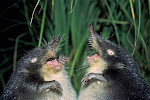
Mysterious sea creatures, including giant sea spiders the size of dinner plates and jelly fish with six meter tentacles, have been found in the murky depths of Antarctica waters, Australian scientists said Tuesday.
Australian experts taking part in an international program to take a census of marine life in the ocean at the far south of the world filmed and captured specimens from up to 1,981 meters (6,500 feet) beneath the surface, and said many may never have been seen before.
"Some of the video footage we have collected is really stunning -- it's amazing to be able to navigate undersea mountains and valleys and actually see what the animals look like in their undisturbed state," Australian scientist Martin Riddle, voyage leader on the research ship Aurora Australis, said.
Among the bizarre-looking creatures the scientists spotted were tunicates, plankton-eating animals that resemble slender glass structures up to a yard tall "standing in fields like poppies,"
Australian experts taking part in an international program to take a census of marine life in the ocean at the far south of the world filmed and captured specimens from up to 1,981 meters (6,500 feet) beneath the surface, and said many may never have been seen before.
"Some of the video footage we have collected is really stunning -- it's amazing to be able to navigate undersea mountains and valleys and actually see what the animals look like in their undisturbed state," Australian scientist Martin Riddle, voyage leader on the research ship Aurora Australis, said.
Among the bizarre-looking creatures the scientists spotted were tunicates, plankton-eating animals that resemble slender glass structures up to a yard tall "standing in fields like poppies,"

Riddle said.
"Gigantism is very common in Antarctic waters -- we have collected huge worms, giant crustaceans and sea spiders the size of dinner plates," Riddle added.
The voyage was part of an international effort to chronicle sea life in the icy ocean and monitor the impact of global warming and other environmental changes on Antarctic waters.
The expedition's three ships, the Aurora Australis, France's L'Astrolabe, and Japan's Umitaka Maru, returned to Australia last month with decks full of sea creatures taken from east Antarctic.

"Gigantism is very common in Antarctic waters -- we have collected huge worms, giant crustaceans and sea spiders the size of dinner plates," Riddle added.
The voyage was part of an international effort to chronicle sea life in the icy ocean and monitor the impact of global warming and other environmental changes on Antarctic waters.
The expedition's three ships, the Aurora Australis, France's L'Astrolabe, and Japan's Umitaka Maru, returned to Australia last month with decks full of sea creatures taken from east Antarctic.

Experts believe the species will help them analyze how rising atmospheric carbon dioxide levels make the oceans more acidic, a factor scientists predict will make it harder for some marine organisms to grow and sustain their calcium carbonate skeletons.
video here


No comments:
Post a Comment